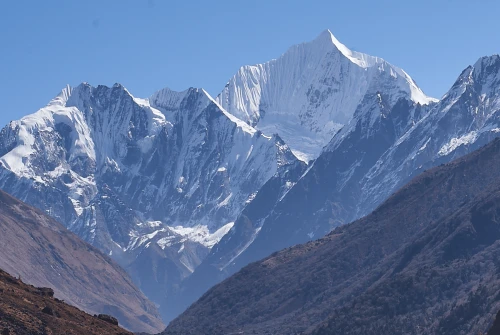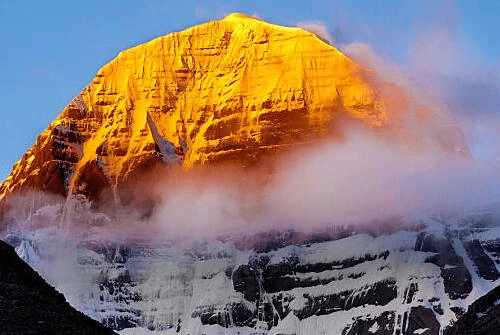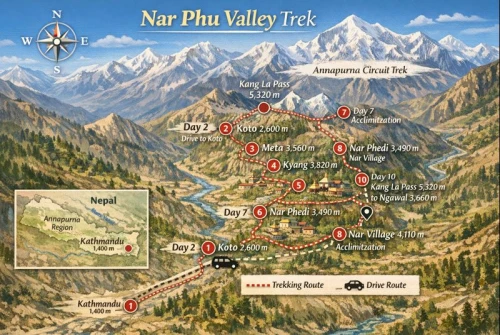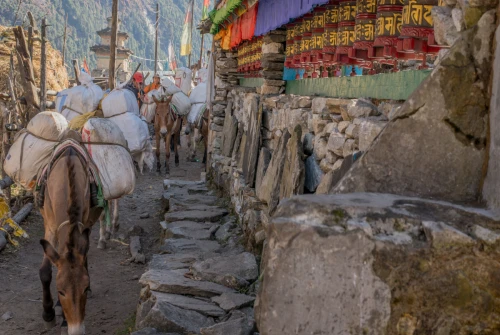Quick Trek Facts – Langtang Valley Trek
Trek Distance: 60 km – 77 km (varies based on selected route and optional side hikes)
- Duration: 6 – 11 days
- Start/End Point: Syabrubesi
Maximum Elevation:Tserko Ri – 5,033 m & Kyanjin Gompa – 3,865 m
Trek Difficulty: Moderate – suitable for trekkers with basic fitness
Accommodation Style: Local teahouses and guesthouses
Best Seasons:
Spring (March to May) – blooming rhododendrons & mild weather and Autumn (September to November) – clear skies & crisp mountain views
Permits Required:
Highlights of the Langtang Valley Trek
Scenic Drive from Kathmandu to Syabrubesi
Journey through terraced hillsides, lush forests, and river valleys on a picturesque mountain road.
Spectacular Mountain Vistas
Soak in jaw-dropping views of Langtang Lirung, Dorje Lakpa, Langshisha Ri, and the Ganesh Himal range.
Unique Himalayan Wildlife Encounters
Spot rare species such as red pandas, Himalayan tahrs, and rhesus monkeys in their natural habitat.
Cultural Immersion in Tamang Villages
Explore traditional settlements deeply influenced by Tibetan heritage, where warm hospitality meets ancient customs.
Visit to Kyanjin Gompa & Local Cheese Factory
Discover a historic Buddhist monastery and sample fresh yak cheese crafted in the heart of the mountains.
Tserko Ri Sunrise Hike (5,033m)
Climb to this stunning viewpoint for panoramic sunrise views over snow-draped Himalayan giants.
Peaceful & Less-Crowded Trails
Escaping the bustle of Everest and Annapurna routes, Langtang offers serenity, solitude, and soul-stirring scenery.
Why Choose the Langtang Valley Trek?
1. Nature: A Tapestry of Himalayan Beauty
Langtang Valley is a sanctuary of natural grandeur, offering trekkers a breathtaking mix of alpine meadows, verdant forests, roaring rivers, and towering snow-covered peaks.The trek follows glacial paths flanked by pine, rhododendron, and bamboo forests teeming with wildlife, including the elusive red panda and Himalayan tahr.Trekkers are treated to panoramic views of iconic Himalayan peaks like Langtang Lirung (7,227m), Dorje Lakpa (6,966m), Langshisha Ri, and Ganesh Himal.
The highlight for many is the sunrise hike to Tserko Ri (5,033m), a natural viewpoint that reveals a 360° sweep of the surrounding Himalayas.Unlike more commercialized trails, the Langtang route remains pristine, quiet, and deeply connected to the land.
2. Culture: A Living Tapestry of Tibetan and Tamang Traditions
Langtang is more than just a trek, it's a cultural journey into the heart of Himalayan Buddhism and mountain heritage. The valley is predominantly inhabited by Tamang communities, whose traditions are heavily influenced by Tibetan Buddhism. Colorful prayer flags flutter across suspension bridges, stone chortens line the trail, and ancient Buddhist monasteries like Kyanjin Gompa invite quiet moments of reflection.
Monks chant in sacred halls while prayer wheels spin slowly in the hands of elders a daily rhythm that brings spiritual depth to the trek.The warmth of the people, their folklore, festivals, and deep reverence for the mountains infuse the journey with meaning.
3. Lifestyle: Authentic Mountain Living
Trekkers experience an unfiltered glimpse into the daily life of highland communities whose routines remain tied to nature and tradition.Villagers rely on yak herding, cheese making, and subsistence farming livelihoods that have supported them for generations in this rugged terrain.
One of the trek’s highlights is a visit to the Kyanjin cheese factory, where you can watch local artisans at work and taste yak cheese made fresh on site.Accommodation is provided by family-run teahouses, where the hospitality is genuine, the food home-cooked, and every evening feels like a shared celebration.These simple, heartfelt interactions reveal a lifestyle that is resilient, self-sufficient, and gracefully in tune with the mountains.
4. History & Resilience: A Trek with a Story
Langtang Valley holds a poignant place in Nepal's recent history as one of the areas most affected by the 2015 earthquake.Entire villages were lost beneath landslides, and yet the local communities rebuilt with extraordinary courage and unity.
By trekking in Langtang, you become part of this recovery story your presence directly supports local families and helps sustain their future.The trail carries a quiet reverence, especially in places like Langtang Village, where rebuilt homes and teahouses stand as symbols of human resilience.This is not just a journey across terrain but through memory, healing, and hope.
5.Close Proximity to Kathmandu
Langtang is the closest Himalayan trekking destination to Nepal’s capital. Just a scenic 6–7 hour drive brings you to Syabrubesi, the starting point of the trek. There’s no need for domestic flights, making the Langtang Trek an ideal option for those on a tighter schedule or budget.
6.Moderate Trek Difficulty
The trek is categorized as moderate and does not require technical climbing experience, making it suitable for both seasoned trekkers and fit beginners.
With a gradual ascent and well-managed itinerary, the trek allows for proper acclimatization, especially around Kyanjin Gompa and Tserko Ri.
7.Fewer Crowds, More Connection
Unlike the crowded trails of Everest Base Camp or the Annapurna Circuit, Langtang offers a peaceful, less-commercialized experience.Trekkers can walk in solitude, connect more deeply with locals, and appreciate nature without the distraction of heavy traffic.
8.A Complete Himalayan Experience in Less Time
In just 7–11 days, Langtang Valley Trek offers stunning mountain views, cultural interaction, wildlife encounters, and spiritual insight a compact yet profound Himalayan journey.
Where does the Langtang Valley Trek start and end?
The Langtang Valley Trek begins with a picturesque and scenic drive from Kathmandu to Syabrubesi, passing through terraced hillsides, winding rivers, and quaint rural villages that offer a glimpse into authentic Nepali life. From Syabrubesi, the trekking trail gradually ascends through dense rhododendron and pine forests, vibrant traditional Tamang villages, and alongside crystal-clear mountain streams.
As you move forward, the trail leads to Lama Hotel, a charming stop nestled amidst verdant landscapes and panoramic mountain views. Continuing the trek, you arrive at Langtang Village, where you can immerse yourself in the rich culture of the local Tamang people and witness the serene beauty of the Langtang National Park.
The journey culminates at Kyanjin Gompa, a spiritual and cultural hub famous for its ancient monastery and the local yak cheese factory. Here, trekkers have the opportunity to embark on a rewarding day hike to Tserko Ri, a towering peak at 5,033 meters, offering breathtaking, panoramic vistas of the Langtang Himalayan range, including iconic peaks like Langtang Lirung, Dorje Lakpa, and Ganesh Himal.
After soaking in the awe-inspiring views and tranquil alpine environment, the trek follows the same route back to Syabrubesi, retracing through lush forests and picturesque villages, before concluding with a drive back to Kathmandu. This route offers a perfect blend of natural beauty, cultural richness, and serene wilderness, making it one of Nepal’s most memorable trekking experiences.
Langtang Valley Trek Itinerary
Day 1: Drive from Kathmandu to Syabrubesi (1,550m) – 6–7 hrs
Day 2: Trek to Lama Hotel (2,480m) – 6 hrs
Day 3: Trek to Langtang Village (3,430m) – 6 hrs
Day 4: Trek to Kyanjin Gompa (3,865m) – 4–5 hrs
Day 5: Hike to Tserko Ri (5,033m) and return to Kyanjin Gompa – 6–7 hrs
Day 6: Trek back to Lama Hotel – 6 hrs
Day 7: Trek to Syabrubesi – 5–6 hrs
Day 8: Drive back to Kathmandu – 6–7 hrs
10-Day Langtang Valley Trek Itinerary
Day 1: Arrival in Kathmandu (1,400m)
Day 2: Drive from Kathmandu to Syabrubesi (1,550m) – 6–7 hrs
Day 3: Trek to Briddhim (2,230m) – 5–6 hrs
Day 4: Trek to Lama Hotel (2,480m) – 6 hrs
Day 5: Trek to Langtang Village (3,430m) – 6–7 hrs
Day 6: Trek to Kyanjin Gompa (3,865m) – 4–5 hrs
Day 7: Hike to Tserko Ri (5,033m) & return to Kyanjin – 6–7 hrs
Day 8: Trek to Thulo Syabru (2,130m) – 6–7 hrs
Day 9: Trek to Dhunche (1,960m) – 4–5 hrs
Day 10: Drive back to Kathmandu & Departure – 6–7 hrs
How to Reach the Trailhead
The Langtang Valley Trek begins with a scenic drive from Kathmandu to Syabrubesi, the official starting point of the trek. Travelers can select from two primary modes of transportation based on their preferences and budget: public bus or private jeep.
The journey offers breathtaking views of terraced hills, rivers, and traditional villages along the way. Driving time varies depending on the chosen vehicle and road conditions but typically ranges from 5 to 8 hours.
Public Bus: The most economical option departs from New Bus Park (Machhapokhari) in Kathmandu. This basic, non-AC bus is often crowded but offers an authentic local travel experience at a cost of NPR 900–1200. The travel duration is usually 7 to 9 hours, depending on traffic and road conditions.
Private Jeep: For a more comfortable and flexible ride, private jeep services can be arranged directly from your hotel or preferred location. The drive takes approximately 6 to 8 hours and costs around NPR 12,000–25,000, ideal for groups as the fare can be shared.
Travel Tip: Road conditions between Kathmandu and Syabrubesi can be rough, especially during the monsoon season (June to August), which may extend travel time. Early morning departures are recommended to avoid traffic delays and to maximize daylight for the trek start.
Required Permits for Langtang Valley Trek
Before starting the Langtang Valley Trek, all trekkers must obtain the necessary permits to ensure a smooth and legal trekking experience. The first essential permit is the TIMS Card (Trekkers’ Information Management System), which costs NPR 2,000. This card is issued by the Nepal Tourism Board and helps authorities monitor and manage trekkers for safety purposes.
Next, trekkers need to purchase the Langtang National Park Entry Permit, which grants access to the protected national park area. The fee for this permit is NPR 3,000 for foreign nationals, while trekkers from SAARC countries pay NPR 1,500. This permit plays a crucial role in preserving the natural environment and wildlife within Langtang National Park.
To obtain these permits, trekkers are required to submit a few important documents. These include valid copies of your passport and visa, recent passport-sized photographs, proof of travel insurance, and a detailed trekking itinerary. Carrying these documents is mandatory for both purchasing permits and for occasional checks during the trek.
It is advisable to carry multiple physical copies of all documents, as well as digital backups on your phone or cloud storage, to ensure you can easily present them when requested.
Permits for Langtang Valley Trek can be obtained conveniently in Kathmandu, either at the Nepal Tourism Board office, the National Parks office, or through authorized trekking agencies. Getting your permits arranged before the trek helps avoid last-minute delays and allows you to focus on enjoying the adventure.
Best Time to Trek Langtang Valley
The most favorable seasons for trekking in the Langtang Valley are spring and autumn, both offering spectacular natural beauty and ideal trekking conditions.
During spring (March to May), the trail is adorned with vibrant blooming rhododendrons and other wildflowers, while clear skies provide breathtaking views of the snow-capped Himalayan peaks. This season is perfect for nature lovers and photographers seeking colorful landscapes and pleasant temperatures.
Autumn (September to November) is another prime trekking season characterized by stable weather, moderate temperatures, and crisp, unobstructed mountain vistas. This period follows the monsoon, leaving fresh air and clear skies, making it ideal for panoramic Himalayan views and comfortable trekking days.
While trekking is possible in winter (December to February), the weather turns significantly colder, especially at higher altitudes where snow may cover the trails. Winter trekking requires proper gear and experience, as temperatures drop sharply and some areas may be slippery or inaccessible.
The monsoon season (June to August) is generally not recommended for trekking in Langtang Valley due to heavy rainfall, slippery trails, increased risk of landslides, and the presence of leeches. Trekkers during this time often face difficult trail conditions and limited visibility.
In summary, for the best experience combining weather, scenery, and trail safety, spring and autumn are the optimal trekking seasons in Langtang Valley.
How difficult is the Langtang Valley Trek ?
The Langtang Valley Trek is considered moderate in difficulty, making it accessible to a wide range of trekkers, including beginners with basic fitness preparation. On average, trekkers walk 5 to 7 hours daily through diverse and sometimes rugged terrain, which includes forest trails, rocky paths, and occasional steep sections.
The primary challenge of the trek is altitude, particularly when reaching higher elevations like Kyanjin Gompa (3,860 meters) and the summit of Tserko Ri (5,033 meters). These high points demand careful acclimatization to avoid altitude sickness, and trekkers are advised to take it slow, stay well-hydrated, and listen to their bodies throughout the journey.
With proper preparation and attention to health, most trekkers can comfortably complete the Langtang trek, enjoying both the physical challenge and the stunning Himalayan landscapes.
What is the estimated total cost for the Langtang Valley Trek?
The estimated total cost for the Langtang Valley Trek typically ranges between $600 and $1200, depending on your choice of services and trekking style. This includes essential expenses such as permits, accommodation, meals, guide and porter services, and transportation.
For budget-conscious travelers, group discounts can make the trek much more affordable, with packages starting from as low as $499 to $600 for an 8-day group trek. Joining a group not only lowers the cost but also enhances the overall experience through shared camaraderie.
If you prefer more personalized service and flexibility, a private trek is available but usually comes at a higher price, often reaching up to $1000 or more, depending on the itinerary and services chosen.
Training & Preparation
To prepare for the Langtang Valley Trek, it is recommended to engage in regular cardio exercises such as jogging, cycling, or swimming for at least 2 to 3 weeks before your departure. Practicing day hikes while carrying a loaded backpack will help build stamina and simulate trekking conditions. Focus on strengthening your legs and maintaining proper hydration throughout your training. If you have any pre-existing health conditions, especially related to the heart or lungs, make sure to consult a healthcare professional before starting the trek to ensure your safety.
Trek Distance and Duration
The Langtang Valley Trek covers an approximate distance of 80 km (50 miles) and typically takes between 8 to 10 days to complete. The journey usually begins at Syabrubesi and ascends to Kyanjin Gompa, located at an altitude of 3,860 meters. Most itineraries include a rewarding side hike to either Kyanjin Ri or Tserko Ri, offering spectacular panoramic views of the Himalayas.
The trek also incorporates acclimatization and exploration days, which are essential for adjusting to the high-altitude terrain and ensuring a safe and enjoyable experience. It’s important to note that these distances and durations are general estimates; actual trekking length and time may vary depending on individual preferences, weather conditions, and group pace.
Altitude & Acclimatization
A gradual ascent is crucial to help your body adjust to the high altitudes encountered during the Langtang Valley Trek. Staying well-hydrated and avoiding alcohol consumption are essential practices to reduce the risk of altitude sickness. Be aware of common symptoms such as headaches, nausea, dizziness, and shortness of breath.
Including rest days in your itinerary allows proper acclimatization and helps prevent severe altitude-related issues. It is recommended to avoid ascending more than 1,000 meters (3,280 feet) in a single day to give your body adequate time to adjust. If symptoms of altitude sickness worsen, immediate descent to lower elevations is critical for safety.
Proper acclimatization not only ensures a healthier trek but also enhances your overall trekking experience by keeping you energized and fit to enjoy the spectacular Himalayan scenery.
Food and Water on the Trek
Along the Langtang Valley Trek, teahouses offer a variety of meals to keep you energized:
Breakfast: Enjoy eggs, warm porridge, pancakes, and freshly baked bread to start your day right.
Lunch & Dinner: Savor traditional Nepali dishes such as dal bhat (lentils with rice and vegetables), momos (Tibetan-style dumplings), fried rice, pasta, and nourishing soups.
Snacks & Drinks: Maintain your energy with energy bars, biscuits, tea, hot chocolate, and soft drinks available at most stops.
Water: Staying hydrated is crucial at high altitudes. You can purchase bottled water along the route, but to reduce plastic waste and ensure safety, it’s best to carry a reusable water bottle and use water purification tablets or filters to treat water from streams or taps in teahouses.
Travel Tip: Bring your favorite snacks and sufficient water purification methods, as shop options may be limited and prices tend to be higher in remote areas. Drinking enough purified or boiled water helps prevent dehydration and altitude sickness during your trek.
Accommodation on the Langtang Valley Trek
Type: The trek offers comfortable stays in traditional teahouses and basic lodges scattered throughout the route. These mountain guesthouses provide a warm and welcoming atmosphere to relax after a day of trekking.
Facilities: Most teahouses feature shared or private rooms with simple bedding. Communal dining areas serve homemade Nepali and Tibetan meals. Hot showers are available but often limited and may require an additional fee. Charging stations for electronic devices are common but usually come with extra charges. Wi-Fi is accessible at some lodges, typically slow and paid.
Tip: During peak trekking seasons in spring (March–May) and autumn (September–November), it’s highly recommended to book accommodations in advance to secure your spot and avoid last-minute hassles, especially in popular stops like Kyanjin Gompa.
Is a Guide Required for the Langtang Valley Trek?
Yes, as of April 2023, hiring a licensed local guide is mandatory for all foreign trekkers in the Langtang region. This new regulation aims to enhance safety, preserve the environment, and support the local economy.
A knowledgeable guide not only ensures safe navigation through the trails but also provides valuable cultural insights, helping trekkers connect deeply with the rich Tamang and Tibetan heritage of the area. Additionally, guides assist with permit checks, emergency situations, and facilitate smoother communication with locals.
Hiring a licensed guide enhances the overall trekking experience, combining safety, cultural immersion, and environmental responsibility.
Alternative Treks in the Langtang Region
The Langtang region offers several captivating trekking alternatives that cater to varying adventure levels and interests:
Langtang–Ganja La Pass Trek
A challenging high-altitude trek that crosses the Ganja La Pass (5,160m), perfect for experienced trekkers seeking rugged terrain, stunning mountain vistas, and less crowded trails.
Langtang–Gosainkunda Trek
Combines the Langtang Valley with a visit to the sacred Gosainkunda Lake (4,380m), blending natural beauty with spiritual significance in a culturally rich setting.
Tamang Heritage Trail
A cultural trek through traditional Tamang villages, offering immersive experiences of local customs, architecture, and hospitality alongside moderate trekking routes.
Helambu Trek
Known for its scenic forests and vibrant culture, Helambu is ideal for those seeking a shorter, less strenuous trek with rich Tamang cultural experiences and panoramic Himalayan views.
Each of these alternative routes provides a unique glimpse into the diverse landscapes, cultures, and natural beauty of the Langtang region, making them excellent options for travelers seeking varied Himalayan adventures
Safety Tips for Langtang Valley Trek
Carry Required Permits and Identification: Always keep your TIMS card, Langtang National Park permit, passport, and ID with you to avoid any issues at checkpoints.
Monitor Weather and Trail Conditions: The Himalayan weather can change rapidly. Check daily forecasts and trail updates to plan safe trekking days and avoid landslides or storms.
Bring a Basic Medical Kit: Include essentials such as painkillers, altitude sickness medication, antiseptics, bandages, and any personal prescriptions to handle minor injuries or illnesses.
Travel with a Licensed Local Guide: Guides provide crucial knowledge of the terrain, weather, altitude precautions, and local culture, enhancing both safety and experience.
Keep Emergency Contacts and Insurance Handy: Carry copies of your travel insurance, emergency rescue numbers, and contact info for your embassy or local authorities.
Stay Hydrated and Pace Yourself: Drink plenty of water to prevent dehydration, and acclimatize properly to avoid altitude sickness.
Packing List Essentials for Langtang Valley Trek
Clothing:
Moisture-wicking base layers to keep dry
Warm fleece jacket for insulation
Waterproof and windproof outerwear to protect against rain and snow
Durable trekking pants and thermal underwear for cold conditions
Gloves and a woollen hat for warmth
Sun cap or wide-brimmed hat for UV protection
Footwear:
Gear:
A reliable sleeping bag rated for cold temperatures
Headlamp with extra batteries for early starts or emergencies
Reusable water bottle or hydration system to stay hydrated
Trekking poles to reduce strain on knees and improve balance
Personal Essentials:
Toiletries including biodegradable soap and wet wipes
High SPF sunscreen and UV-protection sunglasses
Portable phone charger or power bank
Detailed map of the trekking route
Energy snacks like nuts, energy bars, and dried fruit
FAQs
1. Where is the Langtang Trek located?
The Langtang Trek is located in the Langtang National Park region, north of Kathmandu, Nepal. It lies near the Nepal-Tibet border and is part of the Himalayan mountain range.
2. What is the best time to do the Langtang Trek in 2025/2026?
The best months to trek Langtang are spring (March to May) and autumn (September to November) for clear skies, mild temperatures, and beautiful mountain views.
3. How many days does the Langtang Trek usually take?
The trek typically takes 8 to 10 days, depending on your pace and stops. Some itineraries stretch to 12 days for more acclimatization and sightseeing.
4. What is the difficulty level of the Langtang Trek in 2025/2026?
Answer: Langtang Trek is moderate difficulty suitable for trekkers with good basic fitness. No technical climbing skills are required, but you should be prepared for uphill walks and high altitude.
5. Do I need permits for the Langtang Trek?
Yes. You need two permits in 2025:
6. What accommodation options are available along the Langtang trail?
You’ll find teahouses and lodges offering basic rooms, food, and hot showers. Booking in peak seasons (spring/autumn 2025) is recommended to secure accommodation.
7. Is the Langtang Trek safe for solo trekkers?
Yes, Langtang is considered safe for solo trekking in 2025. However, hiring a local guide or joining a group can enhance safety and cultural experience.
8. What altitude will I reach, and is altitude sickness a risk?
The highest point is Kyanjin Gompa at 3,870m (12,700 ft). Altitude sickness is possible; take time to acclimatize, stay hydrated, and recognize symptoms early.
9. What food can I expect on the Langtang Trek?
Local Nepali dishes like dal bhat, momos, and noodles are widely available. Some teahouses also offer Western-style food to suit different tastes.
10. Is there mobile network and internet access on the trek in 2025/2026?
Yes, mobile coverage and Wi-Fi are available in many villages along the trail, but the connection can be slow and intermittent.
11. What essential gear should I pack for the Langtang Trek?
Must-haves for 2025 include:
Trekking boots
Warm layers and waterproof jacket
Sleeping bag (rated for cold temperatures)
Sunscreen and sunglasses
First aid and altitude sickness medication
12. Should I hire a guide or porter for the Langtang Trek?
While optional, hiring a guide or porter is recommended for first-timers to ease the trek, help navigate, and support local communities.
Conclusion
The Langtang Valley Trek presents an unforgettable fusion of breathtaking nature, rich cultural heritage, and peaceful solitude all conveniently close to Kathmandu. Whether you’re a solo explorer, trekking with friends, or an adventure enthusiast eager to escape the crowds of Everest and Annapurna, Langtang promises a unique and deeply fulfilling Himalayan experience.
Immerse yourself in the serene landscapes, connect authentically with the warm-hearted Tamang and Tibetan communities, and marvel at the towering peaks that define this pristine region. With proper preparation, respect for local traditions, and an open heart, your journey through Langtang Valley will create memories to cherish for a lifetime.
Langtang is just one of the many incredible hiking destinations Nepal offers from the iconic Everest Base Camp and Annapurna Circuit to lesser-known trails like Helambu, Manaslu, and the Tamang Heritage Trail. No matter your preference or trekking experience, Nepal’s diverse trails provide unforgettable adventures for every traveler.
For detailed information, customized itineraries, and booking assistance for Langtang Valley Trek or any other Nepal hiking adventures, feel free to reach out and start planning your ultimate Himalayan escape today.
Absolutely! Here’s a refined, topic-wise detailed guide for the Best Time for Langtang Valley Trek, Weather, and Temperature in clear, natural sentences with added insights and keywords to make it engaging and informative.

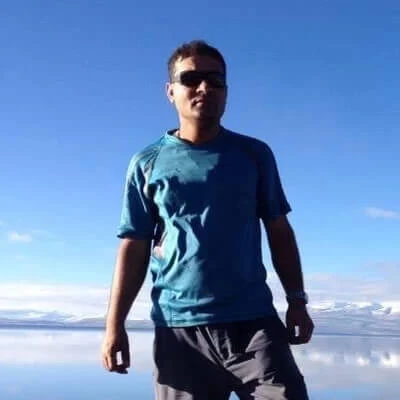
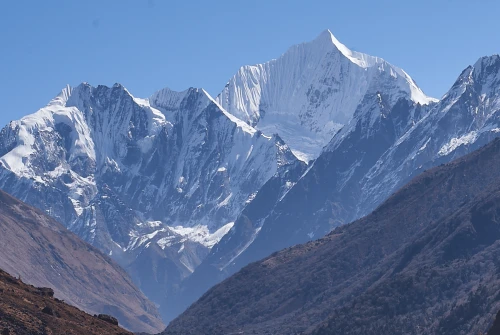
 based on 3 reviews
based on 3 reviews